Hey there, fitness enthusiasts and curious minds! Today, we’re diving into the fascinating world of adaptive physical education methods. Yep, we’re talking about the innovative ways educators are making physical activities accessible and inclusive for everyone. Whether you’re already familiar with this concept or it’s brand spanking new to you, stick around as we explore what makes these methods tick and why they’re such a game-changer.
Read Now : “golf Lessons For Women In The Area”
The Essence of Adaptive Physical Education Methods
So, what exactly are adaptive physical education methods all about? Picture a bustling gym class where everybody, regardless of their abilities, is having a blast participating in activities designed especially for them. These methods are all about inclusivity. They take into account the diverse needs of students, ensuring everyone gets their fair share of movement, joy, and health benefits. Teachers use creative strategies to tailor activities, utilizing specialized equipment or modifying rules to match the students’ individual capabilities. It’s all about leveling the playing field so every student feels empowered and engaged. These techniques acknowledge that one size doesn’t fit all, and that’s absolutely okay. With adaptive physical education methods, the goal is not just physical fitness, but also boosting confidence and fostering a sense of belonging among students.
Key Components of Adaptive Physical Education Methods
1. Personalized Approach: Adaptive physical education methods prioritize a personalized plan that caters to each individual’s needs, ensuring everyone can participate comfortably.
2. Inclusive Environment: Creating an inclusive environment is central, allowing students of all abilities to engage without barriers.
3. Modification and Adaptation: These methods focus on modifying activities to suit diverse abilities, from changing rules to using adaptive equipment.
4. Collaboration with Specialists: Teachers often collaborate with special education professionals to better understand and address students’ needs.
5. Focus on Fun and Participation: By prioritizing fun, adaptive physical education methods keep students motivated and excited to participate.
Benefits of Implementing Adaptive Physical Education Methods
Now, let’s chat about why adaptive physical education methods are a big deal. These methods aren’t just about making activities accessible—they’re about transforming the whole education experience. For starters, they promote physical health and mental well-being by encouraging active participation. Students feel a sense of belonging, as they get to engage alongside their peers, regardless of their abilities. It’s also about building life skills like teamwork, resilience, and empathy. By participating in these inclusive activities, students break stereotypes and develop a mutual respect for individual differences. Adaptive physical education methods create an environment where everyone feels valued, fostering a community spirit that extends beyond the gym.
How to Implement Adaptive Physical Education Methods in Schools
1. Assess Individual Needs: Begin by assessing the needs of your students to understand how best to support them.
2. Engage Parents and Guardians: Involving families in the process can help gather insights and create a supportive environment.
3. Educational Training: Teachers may require additional training to effectively deliver adaptive physical education methods.
4. Leverage Technology: Utilize technology to create engaging and personalized activities.
Read Now : Cheap Golfing Spots Florida
5. Encourage Peer Support: Foster a culture of peer support where students help each other thrive.
6. Continuous Feedback: Gather feedback continuously to improve and adapt methods effectively.
7. Resource Accessibility: Ensure all necessary resources and adaptive equipment are readily available.
8. Partnerships: Building partnerships with local organizations can provide additional support and resources.
9. Regular Review: Regularly review and adjust the methods to ensure they remain effective and inclusive.
10. Celebrate Success: Celebrate the accomplishments of all students to boost morale and encourage further participation.
Creating a Community with Adaptive Physical Education Methods
Building a thriving community within the school is one of the most rewarding aspects of implementing adaptive physical education methods. When every student, regardless of their functional ability, feels like they are part of something bigger, it sparks a sense of camaraderie. These methods pave the way for students to better understand each other’s strengths and challenges, creating an environment where differences are not just accepted but celebrated. Empathy and teamwork flourish, enabling students to grow not just physically, but also emotionally and socially. In essence, adaptive physical education methods are a testament to how inclusive education can shape kinder, more compassionate future generations.
Creating a Culture of Inclusivity
The heart of adaptive physical education methods lies in nurturing a culture of inclusivity. It involves more than just adapting physical activities—it’s about changing mindsets. When students see their peers included and participating, it challenges preconceptions about abilities. This positive and inclusive culture spills over into all areas of schooling, promoting diversity and respect. Creating this cultural shift requires cooperation from everyone—teachers, students, parents, and the community as a whole. Through adaptive physical education methods, we can cultivate an environment where every student is celebrated for who they are, and where differences enhance, rather than divide, us.
Summary of Adaptive Physical Education Methods
In summary, adaptive physical education methods are reshaping how physical education is approached in schools. With their focus on inclusivity, personalization, and community building, they offer numerous benefits to students of all backgrounds and abilities. By tailoring activities and environments to individual needs, these methods ensure everyone has equal opportunities to partake in the joys and challenges of physical education. The ripple effect of adopting such an approach extends beyond the gym or playing field, fostering a more empathetic and understanding community. Students learn vital life skills such as compassion, leadership, and collaboration, all while getting fit and having fun. Teachers and educators are crucial in championing these methods, ensuring every student can shine. With adaptive physical education methods, the focus is clear: it’s not just about physical development, but also about building a more inclusive, supportive, and respectful society.
